FTP Servers: Connecting via Ethernet or Wireless LAN
The camera can connect to FTP servers and upload pictures via existing networks using
Wi-Fi (built-in wireless LAN) or a third-party Ethernet cable inserted in the camera’s
Ethernet connector. The camera can also be connected to FTP servers directly.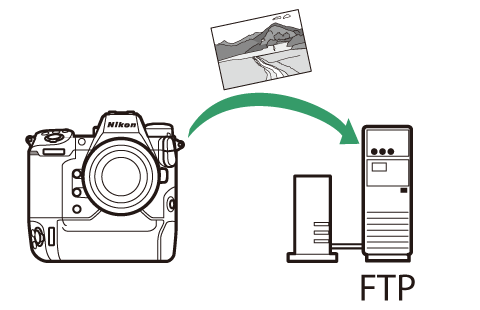
-
Servers can be configured using standard FTP services—including IIS (Internet Information Services)—available with Windows 11 and Windows 10.
-
Internet FTP connections and connection to FTP servers running third-party software are not supported.
Wireless LAN
The camera can connect to FTP servers either by direct wireless link (access-point mode) or via a wireless router on an existing network, including home networks (infrastructure mode).
Direct Wireless Connection (Access-Point Mode)
The camera and FTP server connect via direct wireless link. The camera acts as a wireless
LAN access point, letting you connect when working outdoors and in other situations
in which the computer is not already connected to a wireless network and eliminating
the need for complicated adjustments to settings.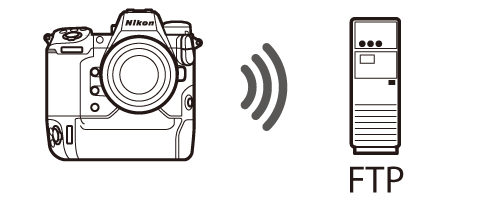
-
Create a host profile using the camera connection wizard.
-
Confirm that [] is selected for [] in the network menu.
-
Select [] in the network menu, then highlight [] and press 2.
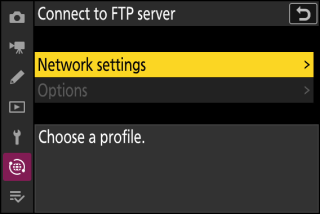
-
Highlight [] and press J.
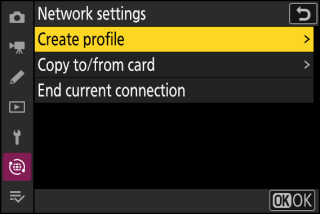
-
Highlight [] and press 2.
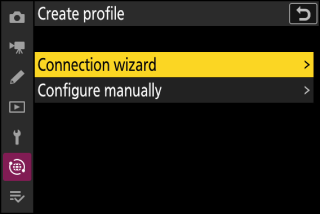
The connection wizard will launch.
Manual ConfigurationChoose [] to configure settings manually.
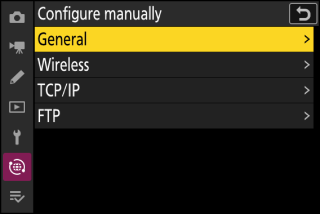
-
Name the new profile.
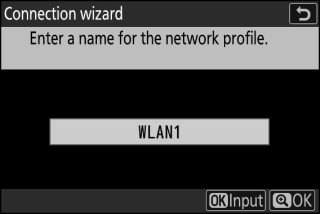
-
To proceed to the next step without changing the default name, press X.
-
Whatever name you choose will appear in the network menu [] > [] list.
-
To rename the profile, press J. For information on text entry, see “Text Entry” (Text Entry). Press X to proceed after entering a name.
-
-
Highlight [] and press J.
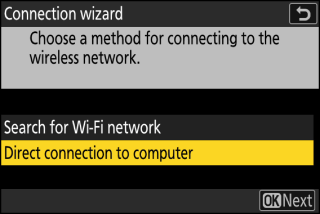
The camera SSID and encryption key will be displayed.
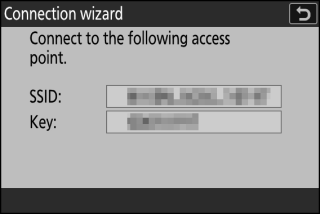
-
Establish a connection to the camera.
Windows:
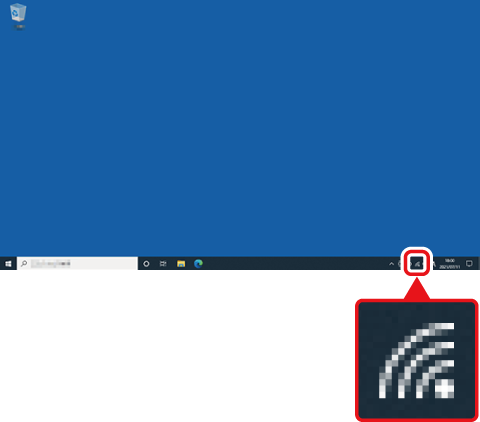
-
Click the wireless LAN icon in the taskbar.
-
Select the SSID displayed by the camera in Step 5.
-
When prompted to enter the network security key, enter the encryption key displayed by the camera in Step 5. The computer will initiate a connection to the camera.
macOS:
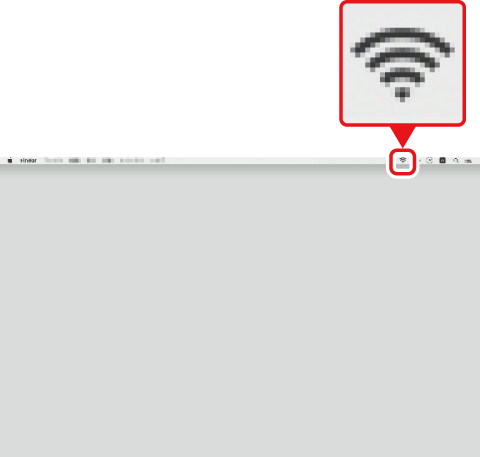
-
Click the wireless LAN icon in the menu bar.
-
Select the SSID displayed by the camera in Step 5.
-
When prompted to enter the network security key, enter the encryption key displayed by the camera in Step 5. The computer will initiate a connection to the camera.
-
-
Choose the server type.
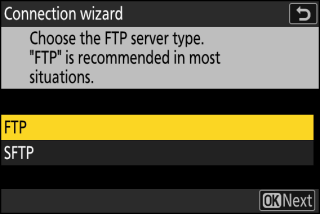
Highlight [] or [] (secure FTP) and press J to display a dialog where you can choose a login method.
-
Log in.
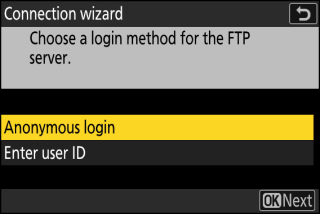
Highlight one of the following options and press J.
Option
Description
[]
Select this option if the server does not require a user ID or password. This option can only be used with servers that are configured for anonymous login. If login is successful, the camera will prompt you to choose a destination.
[]
Enter a user ID and password. Press J to log in when entry is complete. If login is successful, the camera will prompt you to choose a destination.
Firewall SettingsTCP ports 21 and 32768 through 61000 are used for [], TCP ports 22 and 32768 through 61000 for []. File transfer may be blocked if the server firewall is not configured to allow access to these ports.
-
Choose a destination folder.
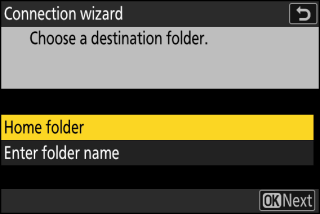
Highlight one of the following options and press J.
Option
Description
[]
Select this option to select the server’s home folder as the destination for pictures uploaded from the camera. A “setup complete” dialog will be displayed if the operation is successful.
[]
Enter the destination folder name manually. The folder must already exist on the server. Enter the folder name and path when prompted and press J to display the “setup complete” dialog.
-
Check the connection.
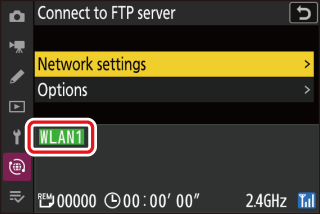
When a connection is established, the profile name will be displayed in green in the camera [] menu.
-
If the profile name is not displayed in green, connect to the camera via the wireless network list on the FTP server.
-
A wireless connection has now been established between the camera and the FTP server.
Pictures taken with the camera can be uploaded to the FTP server as described in“Uploading Pictures” (Uploading Pictures).
Connecting in Infrastructure Mode
The camera connects to an FTP server on an existing network (including home networks)
via a wireless router.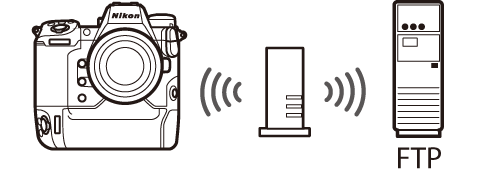
-
Create a host profile using the camera connection wizard.
-
Before connecting to a wireless network, confirm that [] is selected for [] in the network menu.
Infrastructure mode supports connection to FTP servers on different networks.
-
Select [] in the network menu, then highlight [] and press 2.

-
Highlight [] and press J.

-
Highlight [] and press 2.

The connection wizard will launch.
Manual ConfigurationChoose [] to configure settings manually.

-
Name the new profile.

-
To proceed to the next step without changing the default name, press X.
-
Whatever name you choose will appear in the network menu [] > [] list.
-
To rename the profile, press J. For information on text entry, see “Text Entry” (Text Entry). Press X to proceed after entering a name.
-
-
Highlight [] and press J.
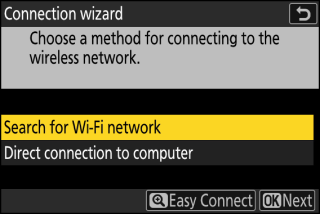
The camera will search for networks currently active in the vicinity and list them by name (SSID).
[]-
To connect without entering an SSID or encryption key, press X in Step 5. Next, press J and choose from the following options:
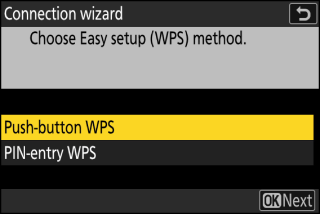
Option
Description
[]
For routers that support push-button WPS. Press the WPS button on the router and then press the camera J button to connect.
[]
The camera will display a PIN. Using a computer, enter the PIN on the router. For more information, see the documentation provided with the router.
-
After connecting, proceed to Step 8.
-
-
Choose a network.
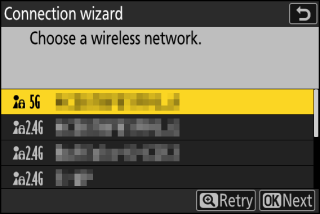
-
Highlight a network SSID and press J.
-
The band on which each SSID operates is indicated by an icon.
-
Encrypted networks are indicated by a h icon. If the selected network is encrypted (h), you will be prompted to enter the encryption key. If the network is not encrypted, proceed to Step 8.
-
If the desired network is not displayed, press X to search again.
Networks with hidden SSIDs are indicated by blank entries in the network list.
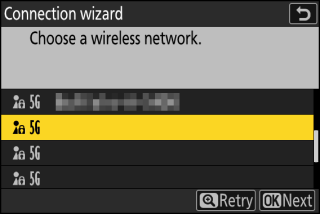
-
To connect to a network with a hidden SSID, highlight a blank entry and press J. Next, press J; the camera will prompt you to provide an SSID.
-
Enter the network name and press X. Press X again; the camera will now prompt you to enter the encryption key.
-
-
Enter the encryption key.
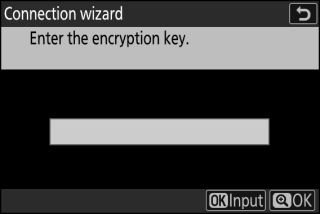
-
Press J and enter the encryption key for the wireless router.
-
For more information, see the documentation for the wireless router.
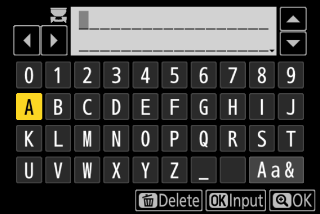
-
Press X when entry is complete.
-
Press X again to initiate the connection. A message will be displayed for a few seconds when the connection is established.
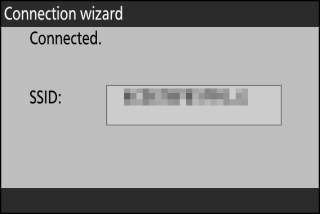
-
-
Obtain or select an IP address.
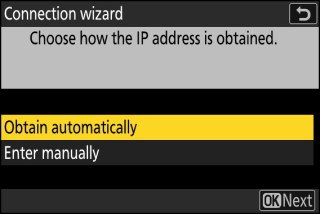
-
Highlight one of the following options and press J.
Option
Description
[]
Select this option if the network is configured to supply the IP address automatically. A “configuration complete” message will be displayed once an IP address has been assigned.
[]
Enter the IP address and sub-net mask manually.
-
Press J; you will be prompted to enter the IP address.
-
Rotate the main command dial to highlight segments.
-
Press 4 or 2 to change the highlighted segment and press J to save changes.
-
Next, press X; a “configuration complete” message will be displayed. Press X again to display the sub-net mask.
-
Press 1 or 3 to edit the sub-net mask and press J; a “configuration complete” message will be displayed.
-
-
Press J to proceed when the “configuration complete” message is displayed.
-
-
Choose the server type.

Highlight [] or [] (secure FTP) and press J to display a dialog where you can enter the server address.
-
Enter the server address.
-
Press J to enter the server URL or IP address.

-
Press X when entry is complete.

-
Press X again to connect to the FTP server. You will be prompted to choose a login method.
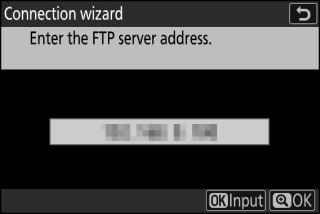
-
-
Log in.

Highlight one of the following options and press J.
Option
Description
[]
Select this option if the server does not require a user ID or password. This option can only be used with servers that are configured for anonymous login. If login is successful, the camera will prompt you to choose a destination.
[]
Enter a user ID and password. Press J to log in when entry is complete. If login is successful, the camera will prompt you to choose a destination.
Firewall SettingsTCP ports 21 and 32768 through 61000 are used for [], TCP ports 22 and 32768 through 61000 for []. File transfer may be blocked if the server firewall is not configured to allow access to these ports.
-
Choose a destination folder.

Highlight one of the following options and press J.
Option
Description
[]
Select this option to select the server’s home folder as the destination for pictures uploaded from the camera. A “setup complete” dialog will be displayed if the operation is successful.
[]
Enter the destination folder name manually. The folder must already exist on the server. Enter the folder name and path when prompted and press J to display the “setup complete” dialog.
-
Check the connection.

When a connection is established, the profile name will be displayed in green in the camera [] menu.
A wireless connection has now been established between the camera and the FTP server.
Pictures taken with the camera can be uploaded to the FTP server as described in“Uploading Pictures” (Uploading Pictures).
Ethernet
The camera can connect to FTP servers either directly or via existing networks using a third-party Ethernet cable inserted in the camera’s Ethernet connector.
Connecting an Ethernet Cable
Connect an Ethernet cable to the camera’s Ethernet connector. Do not use force or attempt to insert the connectors at an angle. Connect the other end of the cable to the FTP server or a router.
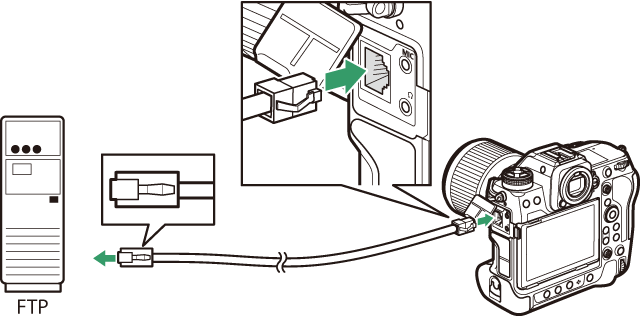
-
Select [] for [] in the network menu.
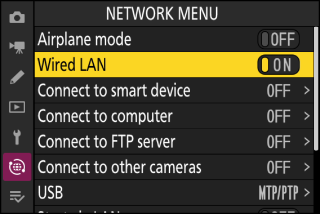
-
Select [] in the network menu, then highlight [] and press 2.

-
Highlight [] and press J.

-
Highlight [] and press 2.

The connection wizard will launch.
Manual ConfigurationChoose [] to configure settings manually.
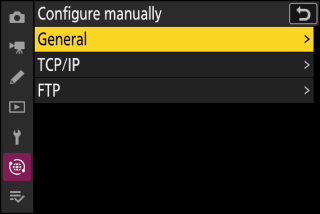
-
Name the new profile.
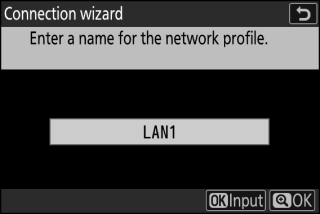
-
To proceed to the next step without changing the default name, press X.
-
Whatever name you choose will appear in the network menu [] > [] list.
-
To rename the profile, press J. For information on text entry, see “Text Entry” (Text Entry). Press X to proceed after entering a name.
-
-
Obtain or select an IP address.

-
Highlight one of the following options and press J.
Option
Description
[]
Select this option if the network is configured to supply the IP address automatically. A “configuration complete” message will be displayed once an IP address has been assigned.
[]
Enter the IP address and sub-net mask manually.
-
Press J; you will be prompted to enter the IP address.
-
Rotate the main command dial to highlight segments.
-
Press 4 or 2 to change the highlighted segment and press J to save changes.
-
Next, press X; a “configuration complete” message will be displayed. Press X again to display the sub-net mask.
-
Press 1 or 3 to edit the sub-net mask and press J; a “configuration complete” message will be displayed.
-
-
Press J to proceed when the “configuration complete” message is displayed.
-
-
Choose the server type.

Highlight [] or [] (secure FTP) and press J to display a dialog where you can enter the server address.
-
Enter the server address.
-
Press J to enter the server URL or IP address.

-
Press X when entry is complete.

-
Press X again to connect to the FTP server. You will be prompted to choose a login method.

-
-
Log in.

Highlight one of the following options and press J.
Option
Description
[]
Select this option if the server does not require a user ID or password. This option can only be used with servers that are configured for anonymous login. If login is successful, the camera will prompt you to choose a destination.
[]
Enter a user ID and password. Press J to log in when entry is complete. If login is successful, the camera will prompt you to choose a destination.
Firewall SettingsTCP ports 21 and 32768 through 61000 are used for [], TCP ports 22 and 32768 through 61000 for []. File transfer may be blocked if the server firewall is not configured to allow access to these ports.
-
Choose a destination folder.

Highlight one of the following options and press J.
Option
Description
[]
Select this option to select the server’s home folder as the destination for pictures uploaded from the camera. A “setup complete” dialog will be displayed if the operation is successful.
[]
Enter the destination folder name manually. The folder must already exist on the server. Enter the folder name and path when prompted and press J to display the “setup complete” dialog.
-
Check the connection.

When a connection is established, the profile name will be displayed in green in the camera [] menu.
A connection has now been established between the camera and the FTP server.
Pictures taken with the camera can be uploaded to the FTP server as described in“Uploading Pictures” (Uploading Pictures).
Uploading Pictures
Pictures can be selected for upload during playback. They can also be uploaded automatically as they are taken.
-
Before uploading pictures, connect the camera and FTP server via Ethernet or a wireless network. Connect using a host profile selected via the [] > [] list.

-
When a connection is established, the profile name will be displayed in green in the camera [] menu.

Select a host profile and enable camera Wi-Fi before connecting.
Selecting Pictures for Upload
-
Press the K button on the camera and select full-frame or thumbnail playback.
-
Select a picture and press the i button.
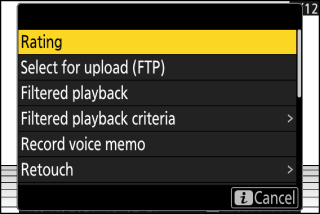
-
Highlight [] and press J.
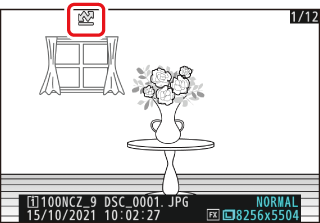
-
A white “priority upload” icon will appear on the picture. If the camera is currently connected to a network, upload will begin immediately and the icon will turn green.
-
Otherwise, upload will begin when a connection is established.
-
Repeat Steps 2–3 to upload additional pictures.
-
-
Repeat Steps 2–3 to remove upload marking from selected pictures.
-
To remove upload marking from all pictures, select [] > [] > [] in the network menu.
The [] item in the playback i menu can be used to display only pictures that meet chosen criteria (Filtered Playback). The pictures can then all be selected for upload by highlighting [] in the i menu and pressing J.
Uploading Photos as They Are Taken
To upload new photos as they are taken, select [] for [] > [] > [] in the network menu.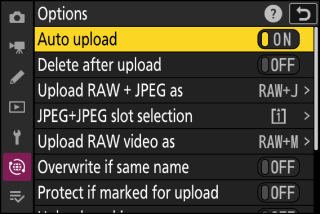
-
Upload begins only after the photo has been recorded to the memory card. Be sure a memory card is inserted in the camera.
-
Videos are not uploaded automatically. They must instead be uploaded manually from the playback display.
The Upload Icon
Upload status is indicated by the upload icon.
s (white): Priority upload
The picture has been manually selected for upload. Pictures marked with this icon will be uploaded before pictures marked W (“upload”).
W (white): Upload
The picture has been selected for upload but upload has not yet begun.
X (green): Uploading
Upload in progress.
Y (blue): Uploaded
Upload complete.
The [Connect to FTP Server] Upload Status Display
The [] display shows the following:
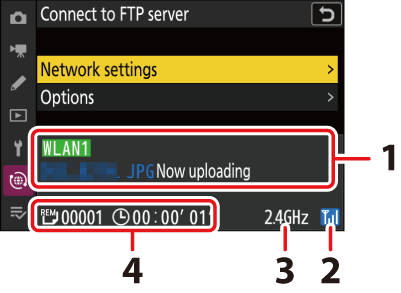
| 1 |
Status: The status of the connection to the host. The profile name is displayed in green when a connection is established. While files are being transferred, the status display shows “Now uploading” preceded by the name of the file being sent. Errors and error codes are also displayed here (Error Codes). |
|---|---|
| 2 |
Signal strength: Ethernet connections are shown by d. When the camera is connected to a wireless network, the icon instead shows the wireless signal strength. |
| 3 |
Band: The band used by the wireless network to which the camera is connected in infrastructure mode. |
|---|---|
| 4 |
Pictures/time remaining: The number of pictures remaining and the time needed to send them. The time remaining is an estimate only. |
Wireless transmission may be interrupted if the signal is lost. Upload of pictures with upload marking can be resumed by turning the camera off and then on again once the signal has been re-established.
Do not remove the memory card or disconnect the Ethernet cable during upload.
The copies on the FTP server will not be protected even if the originals are. Markings can be added using ratings (Rating Pictures).
Voice memos will be included when the associated pictures are transmitted. They cannot, however, be uploaded separately.
The camera saves transfer marking when turned off and resumes upload when next turned on.
Connection status is shown by the camera network indicator.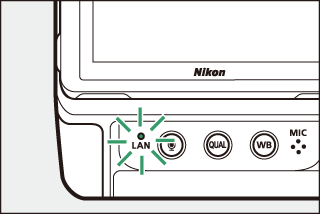
|
Network indicator |
Status |
|---|---|
|
I (off) |
No connection. |
|
K (green) |
Waiting to connect. |
|
H (flashes green) |
Connected. |
|
H (flashes amber) |
Error. |
Ending the Connection to the FTP Server
You can end the connection by:
-
turning the camera off,
-
selecting [] for [] > [] in the network menu, or
-
connecting to a smart device via Wi-Fi or Bluetooth.
An error will occur if the FTP server’s wireless connection is disabled before the camera’s. Disable camera’s connection first.
